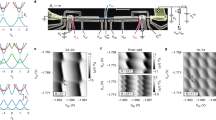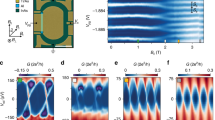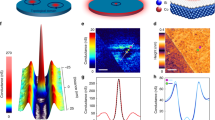Abstract
Majorana zero modes are quasiparticle excitations in condensed matter systems that have been proposed as building blocks of fault-tolerant quantum computers1. They are expected to exhibit non-Abelian particle statistics, in contrast to the usual statistics of fermions and bosons, enabling quantum operations to be performed by braiding isolated modes around one another1,2. Quantum braiding operations are topologically protected insofar as these modes are pinned near zero energy, with the departure from zero expected to be exponentially small as the modes become spatially separated3,4. Following theoretical proposals5,6, several experiments have identified signatures of Majorana modes in nanowires with proximity-induced superconductivity7,8,9,10,11 and atomic chains12, with small amounts of mode splitting potentially explained by hybridization of Majorana modes13,14,15. Here, we use Coulomb-blockade spectroscopy in an InAs nanowire segment with epitaxial aluminium, which forms a proximity-induced superconducting Coulomb island (a ‘Majorana island’) that is isolated from normal-metal leads by tunnel barriers, to measure the splitting of near-zero-energy Majorana modes. We observe exponential suppression of energy splitting with increasing wire length. For short devices of a few hundred nanometres, sub-gap state energies oscillate as the magnetic field is varied, as is expected for hybridized Majorana modes. Splitting decreases by a factor of about ten for each half a micrometre of increased wire length. For devices longer than about one micrometre, transport in strong magnetic fields occurs through a zero-energy state that is energetically isolated from a continuum, yielding uniformly spaced Coulomb-blockade conductance peaks, consistent with teleportation via Majorana modes16,17. Our results help to explain the trivial-to-topological transition in finite systems and to quantify the scaling of topological protection with end-mode separation.
This is a preview of subscription content, access via your institution
Access options
Subscribe to this journal
Receive 51 print issues and online access
$199.00 per year
only $3.90 per issue
Buy this article
- Purchase on Springer Link
- Instant access to full article PDF
Prices may be subject to local taxes which are calculated during checkout




Similar content being viewed by others
References
Kitaev, A. Y. Fault-tolerant quantum computation by anyons. Ann. Phys. 303, 2–30 (2003)
Nayak, C., Simon, S. H., Stern, A., Freedman, M. & Das Sarma, S. Non-Abelian anyons and topological quantum computation. Rev. Mod. Phys. 80, 1083–1159 (2008)
Read, N. & Green, D. Paired states of fermions in two dimensions with breaking of parity and time-reversal symmetries, and the fractional quantum Hall effect. Phys. Rev. B 61, 10267–10297 (2000)
Kitaev, A. Y. Unpaired Majorana fermions in quantum wires. Phys.Usp. 44, 131–136 (2001)
Lutchyn, R. M., Sau, J. D. & Das Sarma, S. Majorana fermions and a topological phase transition in semiconductor-superconductor heterostructures. Phys. Rev. Lett. 105, 077001 (2010)
Oreg, Y., Refael, G. & von Oppen, F. Helical liquids and Majorana bound states in quantum wires. Phys. Rev. Lett. 105, 177002 (2010)
Mourik, V. et al. Signatures of Majorana fermions in hybrid superconductor-semiconductor nanowire devices. Science 336, 1003–1007 (2012)
Rokhinson, L. P., Liu, X. & Furdyna, J. K. The fractional a.c. Josephson effect in a semiconductor–superconductor nanowire as a signature of Majorana particles. Nature Phys. 8, 795–799 (2012)
Das, A. et al. Zero-bias peaks and splitting in an Al–InAs nanowire topological superconductor as a signature of Majorana fermions. Nature Phys. 8, 887–895 (2012)
Deng, M. T. et al. Anomalous zero-bias conductance peak in a Nb–InSb nanowire–Nb hybrid device. Nano Lett. 12, 6414–6419 (2012)
Churchill, H. O. H. et al. Superconductor-nanowire devices from tunneling to the multichannel regime: zero-bias oscillations and magnetoconductance crossover. Phys. Rev. B 87, 241401 (2013)
Nadj-Perge, S. et al. Observation of Majorana fermions in ferromagnetic atomic chains on a superconductor. Science 346, 602–607 (2014)
Das Sarma, S., Sau, J. D. & Stanescu, T. D. Splitting of the zero-bias conductance peak as smoking gun evidence for the existence of the Majorana mode in a superconductor-semiconductor nanowire. Phys. Rev. B 86, 220506 (2012)
Stanescu, T. D., Lutchyn, R. M. & Das Sarma, S. Dimensional crossover in spin-orbit-coupled semiconductor nanowires with induced superconducting pairing. Phys. Rev. B 87, 094518 (2013)
Rainis, D., Trifunovic, L., Klinovaja, J. & Loss, D. Towards a realistic transport modeling in a superconducting nanowire with Majorana fermions. Phys. Rev. B 87, 024515 (2013)
Fu, L. Electron teleportation via Majorana bound states in a mesoscopic superconductor. Phys. Rev. Lett. 104, 056402 (2010)
Hützen, R., Zazunov, A., Braunecker, B., Yeyati, A. L. & Egger, R. Majorana single-charge transistor. Phys. Rev. Lett. 109, 166403 (2012)
Krogstrup, P. et al. Epitaxy of semiconductor–superconductor nanowires. Nature Mater. 14, 400–406 (2015)
Hekking, F., Glazman, L., Matveev, K. & Shekhter, R. Coulomb blockade of two-electron tunneling. Phys. Rev. Lett. 70, 4138–4141 (1993)
Hergenrother, J., Tuominen, M. & Tinkham, M. Charge transport by Andreev reflection through a mesoscopic superconducting island. Phys. Rev. Lett. 72, 1742–1745 (1994)
Higginbotham, A. P. et al. Parity lifetime of bound states in a proximitized semiconductor nanowire. Nature Phys. 11, 1017–1021 (2015)
Eiles, T. M., Martinis, J. M. & Devoret, M. H. Even-odd asymmetry of a superconductor revealed by the Coulomb blockade of Andreev reflection. Phys. Rev. Lett. 70, 1862–1865 (1993)
Tuominen, M. T., Hergenrother, J. M., Tighe, T. S. & Tinkham, M. Experimental evidence for parity-based 2e periodicity in a superconducting single-electron tunneling transistor. Phys. Rev. Lett. 69, 1997–2000 (1992)
Lafarge, P., Joyez, P., Esteve, D., Urbina, C. & Devoret, M. H. Measurement of the even-odd free-energy difference of an isolated superconductor. Phys. Rev. Lett. 70, 994–997 (1993)
Matveev, K. A., Glazman, L. I. & Shekhter, R. I. Effects of charge parity in tunneling through a superconducting grain. Mod. Phys. Lett. B 08, 1007–1026 (1994)
Csonka, S., Hofstetter, L., Freitag, F. & Oberholzer, S. Giant fluctuations and gate control of the g-factor in InAs nanowire quantum dots. Nano Lett. 8, 3932–3935 (2008)
Schroer, M. D., Petersson, K. D., Jung, M. & Petta, J. R. Field tuning the g factor in InAs nanowire double quantum dots. Phys. Rev. Lett. 107, 176811 (2011)
Cole, W. S., Das Sarma, S. & Stanescu, T. D. Effects of large induced superconducting gap on semiconductor Majorana nanowires. Phys. Rev. B 92, 174511 (2015)
Fasth, C., Fuhrer, A., Samuelson, L., Golovach, V. N. & Loss, D. Direct measurement of the spin-orbit interaction in a two-electron InAs nanowire quantum dot. Phys. Rev. Lett. 98, 266801 (2007)
Sau, J. D., Swingle, B. & Tewari, S. Proposal to probe quantum nonlocality of Majorana fermions in tunneling experiments. Phys. Rev. B 92, 020511 (2015)
Acknowledgements
We thank K. Flensberg, M. Leijnse, M. Deng, W. Chang and R. Lutchyn for discussions, and G. Ungaretti, S. Upadhyay, C. Sørensen, M. von Soosten and D. Sherman for contributions to growth and fabrication. This research was supported by Microsoft Project Q, the Danish National Research Foundation, the Lundbeck Foundation, the Carlsberg Foundation and the European Commission. C.M.M. acknowledges support from the Villum Foundation.
Author information
Authors and Affiliations
Contributions
P.K., T.S.J. and J.N. developed the nanowire materials. S.M.A. fabricated the devices. S.M.A., A.P.H. and M.M. carried out the measurements with input from F.K., T.S.J. and C.M.M. Data analysis was done by S.M.A., A.P.H. and M.M. All authors contributed to interpreting the data. The manuscript was written by S.M.A., A.P.H. and C.M.M. with suggestions from all other authors.
Corresponding author
Ethics declarations
Competing interests
The authors declare no competing financial interests.
Extended data figures and tables
Extended Data Figure 1 Device layouts.
Gate pattern for the five measured devices showing applied voltage bias VSD, measured current I and gate voltage VG.
Extended Data Figure 2 Summary of even–odd peak spacing.
a–i, Peak spacings for even and odd valleys Se,o versus applied magnetic field B‖, B⊥ or Btr (similar to Fig. 2b) for different device lengths. Left axis shows peak spacings; right axis shows corresponding energy scales, converting from gate voltage to energy by the lever arm η, which is measured independently from Coulomb-blockade diamonds. Insets show a magnification of the first energy splitting with an arrow indicating where A is measured. j, Cross-section of the nanowire, showing the applied field directions B‖, B⊥ and Btr.
Extended Data Figure 3 Critical field measurement for the L = 0.9 μm device.
a, Conductance g versus gate voltage VG and parallel magnetic field B‖ at zero bias showing the 2e-to-1e peak splitting. b, Conductance versus source–drain voltage VSD and B‖, taken at VG = −14.92 V, showing a closing of the superconducting gap at Bc ≈ 640 mT, more than 500 mT after the onset of 1e periodicity.
Extended Data Figure 4 Oscillating 1e-periodic peak spacings.
a, Zero-bias conductance g versus gate voltage VG and parallel magnetic field B‖ at zero bias showing the 2e-to-1e peak splitting for L = 0.9 μm. The fitted peak position is indicated by a red line; even and odd peak spacings Se,o are indicated by white arrows. b, Peak spacing for even and odd valleys as a function of B‖. The plot shows the average peak spacings 〈Se,o〉 as well as the individual peak spacings Se,o.
Extended Data Figure 5 Angle dependence of state-continuum anti-crossing.
a–f, Differential conductance g as a function of source–drain bias VSD and magnetic field Bα for different angles (α = 22.5°–157.5°) in the plane perpendicular to the nanowire direction. Measurements are from the L = 400 nm device.
Extended Data Figure 6 Gate positions.
a, Differential conductance g as a function of gate voltage VG and parallel magnetic field B‖ for the L = 330 nm device. Three different gate positions are indicated by coloured horizontal lines. b–d, Differential conductance as function of bias voltage VSD and B‖ for the three gate voltages in a.
Extended Data Figure 7 Comparison of peak spacings and bias spectroscopy.
a, Peak spacing for even and odd valleys 〈Se,o〉 versus applied field B⊥. b, Differential conductance g as a function of source–drain bias VSD and magnetic field B⊥.
Extended Data Figure 8 Common-mode peak motion removal.
a, Differential conductance g versus gate voltage VG and applied magnetic field B‖ for the L = 1.5 μm device. b, Same as a, but with effective gate voltage VG,eff defined to remove common-mode peak motion. The reference Coulomb peak that is used for common-mode removal is labelled.
Extended Data Figure 9 Zero-energy state.
a, Differential conductance g as a function of bias voltage VSD and gate voltage VG for the L = 1.5 μm device and B‖ = 270 mT, showing an evenly spaced Coulomb diamond pattern and the associated gapped zero-energy state. b, Differential conductance versus bias voltage at the gate voltages indicated by coloured ticks in a. At these VG values, the presence of a zero-energy state is indicated by a zero-bias peak.
Extended Data Figure 10 Bias-spectroscopy at successive Coulomb peaks.
a, Differential conductance g versus effective gate voltage VG,eff and applied magnetic field B‖. VG,eff is defined to remove common-mode peak motion; see Methods section ‘Bias spectroscopy of the long device’. b, Differential conductance versus source–drain bias VSD and applied magnetic field B‖ at fixed VG,eff indicated by the coloured ticks on the right axis of a.
Extended Data Figure 11 Measurement of the g-factor for three devices.
a, Differential conductance g versus source–drain voltage VSD and applied magnetic field B‖ for the L = 330 nm device, showing a g-factor of 23. b, c, Average even and odd peak spacings 〈Se,o〉 as a function of B‖ for the L = 790 nm and L = 0.9 μm devices, showing extracted g-factors of 20 and 50, respectively.
Rights and permissions
About this article
Cite this article
Albrecht, S., Higginbotham, A., Madsen, M. et al. Exponential protection of zero modes in Majorana islands. Nature 531, 206–209 (2016). https://doi.org/10.1038/nature17162
Received:
Accepted:
Published:
Issue Date:
DOI: https://doi.org/10.1038/nature17162
This article is cited by
-
Hosohedral nodal-line superconductivity in hexagonal ABC Dirac semimetals
Communications Physics (2024)
-
Superconducting tunnel junctions with layered superconductors
Quantum Frontiers (2024)
-
Intermediate states in Andreev bound state fusion
Communications Physics (2023)
-
In search of Majorana
Nature Physics (2023)
-
Conductance spectroscopy of Majorana zero modes in superconductor-magnetic insulator nanowire hybrid systems
Communications Physics (2023)
Comments
By submitting a comment you agree to abide by our Terms and Community Guidelines. If you find something abusive or that does not comply with our terms or guidelines please flag it as inappropriate.



